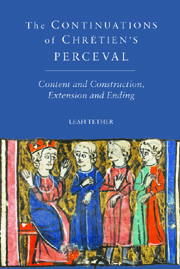Book contents
- Frontmatter
- Contents
- Acknowledgements
- Abbreviations and MS Sigla
- Introduction
- 1 Authorial Changeovers in the Manuscripts
- 2 Distinguishing Continuations, Sequels and Ends
- 3 The First Continuation and Prolongation
- 4 The Second Continuation and the Imitative Mode
- 5 The Gerbert and Manessier Continuations: Interpolation vs. Conclusion
- Conclusion
- Appendices
- Bibliography
- Index
- ARTHURIAN STUDIES
Introduction
Published online by Cambridge University Press: 05 February 2013
- Frontmatter
- Contents
- Acknowledgements
- Abbreviations and MS Sigla
- Introduction
- 1 Authorial Changeovers in the Manuscripts
- 2 Distinguishing Continuations, Sequels and Ends
- 3 The First Continuation and Prolongation
- 4 The Second Continuation and the Imitative Mode
- 5 The Gerbert and Manessier Continuations: Interpolation vs. Conclusion
- Conclusion
- Appendices
- Bibliography
- Index
- ARTHURIAN STUDIES
Summary
Chrétien de Troyes left his fifth and final romance, the Conte du Graal, unfinished, hanging mid-sentence, probably owing to his death. It is well known that his central object, the Grail, went on to become one of the most enigmatic in all literature, and one which endures today. Chrétien's story, as well as the many other medieval texts to adopt the Grail theme, have been endlessly examined and analysed as a result of their contribution to the transmission of the eternal motif, as well as their protracted influence on the literatures of both the medieval and modern worlds. Significantly, however, scholars searching for examples of the contemporary response to this extremely important romance have, until recently, often overlooked the works of four particular authors. These authors were among the very first to react to the call of Chrétien's unfinished tale and, collectively, they composed in excess of 69,000 lines designed to emanate directly from Chrétien's final utterance. We refer to them today as the ‘Continuators’. Their works are known collectively as the Perceval Continuations, and individually as follows:
The First Continuation (or the Gauvain Continuation, la Continuation-Gauvain or the Pseudo-Wauchier Continuation), composed anonymously around 1200.
The Second Continuation (or the Perceval Continuation, la Continuation-Perceval or the Wauchier Continuation) composed by Wauchier de Denain no later than 1210.
The Gerbert Continuation (or the Fourth Continuation or the Continuation de Gerbert) composed by Gerbert de Montreuil around 1225.
The Manessier Continuation (or the Third Continuation or the Continuation de Manessier) composed by Manessier around 1225.
- Type
- Chapter
- Information
- The 'Continuations' of Chrétien's 'Perceval'Content and Construction, Extension and Ending, pp. 1 - 20Publisher: Boydell & BrewerPrint publication year: 2012

